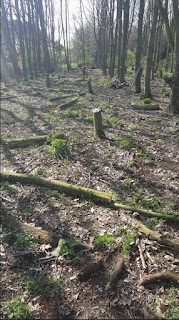Planting Tulip Wood
The plantation was a P 1970s mature block of woodland. I originally called it The Plantation but now call it the Tulip Wood. All my woods are technically plantations. It was mainly Rows of large sycamore separated by Rows of Red and Native Oak. Grey Alder had been planted on the wettest parts. The site is essentially flat but a central area is few inches lower. There is a stream along one side, into which the ditch between the Triangular and Rectangular fields feeds. The Sycamore were large trees and dominated. They all tended to be forked at 4-10 feet, otherwise they might have made timber. Back in 2018 I had took down two pairs of rows, removing Grey Alder (Alnus incana), some etiolated native Oak and diseased Red Oak. The Red Oak had healthy canopies but several had small bleeds, two had small Ganoderma brackets and one with large Ganoderma brackets had blown down 2015.
 |
| Images of the original line felling. |
The rows of Sycamore were considered too big for me to bring down and do something with. Sycamore limbs that could be reached were removed. The first area was planted with Douglas Fir, but drought meant I ended up beating up extensively with the Coast Redwood I had intended for the second pair of rows. Western Red Cedar and European Silver Fir were bought into the mix together with Monterey Pine from seed I had collected.
 |
| . |
 |
| The clear felled area planted Oct 2021. |
browsing Oak and Douglas. 2023 recycled Tubex guards were put around the broad leaf trees, 120cm where the tree was nearly 120 or above and 75cm when not. Most of these trees that had not been browsed were 100 cm+ . Most of the Tulip Trees could self support but the oaks were very spindly. This did free up a lot of herbicide mesh guards and cut down guards for future planting.
 |
| Sept 2023. South side Tulip Wood everything growing well. |
 |
| Sept 2023 North side of Tulip Wood. Trees growing less well. |
There is a lot of coppice regrowth, Sycamore regeneration, Alder suckering and Elderberry. This needs removing over the winter and I will look at taking down some bits of the Sycamore. The shading is too great and the longer they are left the harder it will be and the greater the collateral damage.
Picture on the left shows underplanted conifers between over towering Sycamores (Sept 2023). Many of the original Douglas fir suffered from browsing, drought and fraying. Those that were lost were replaced by Coast Redwood the first year. Those that were lost later are now gaps. Those that were planted outside the Sycamores are much larger, hence the hope to reduce some of the remaining Sycamores and Elder.





No comments:
Post a Comment